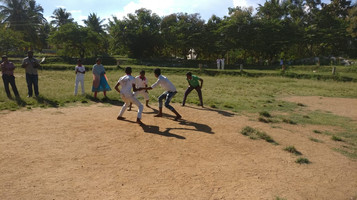Design, strategy and A Few Other Things
REIMAGINING MASCULINITY
DESIGN RESEARCH
OBJECTIVE
COLLABORATORS: IT for change | Srishti institute of design
Redefining gender roles for school children in rural Mysore | Creating a framework and suggestions to build weekly activities that the NGO will conduct with the boys in the upcoming year
BACKGROUND:
-
IT for Change is an NGO based in Bengaluru, which demonstrates alternative ways in which digital technologies can be envisioned, and programs designed and implemented, to strengthen the marginalized sections of society.
-
Prakriye field centre has been working with adolescent girls by holding innovative digital media-based learning dialogues to strengthen their agency and leadership
-
They are expanding the scope of its work to reach out to adolescent boys as without creating alternative imaginaries of masculinities at the local level, it is difficult to make progress in the area of empowering adolescent girls.
-
It for Change and Prakriye are in the process of brainstorming the curriculum for these learning as a part of the strategic design.
-
The particular challenge and an opportunity are to explore how the methods of design inquiry can be brought together to aid and assist in the goals of Prakriye, in this stage and beyond.
RESEARCH OBJECTIVE AND CONTEXT:



INTERACTION DAY 1:

We did two activities with the kids - Daily routine mapping | likes and dislikes
-
Daily routine mapping: We asked the kids to map their daily activities starting from sunrise to sunset.
-
Likes and dislikes: The children wrote their likes and dislikes of the kids


INSIGHTS:

We found that the first day's data collection was not all that effective because we had activities that mostly writing. The boys expected some sort of physical activity and they got restless seeing the other group playing.
-
Most of the boys worked in the fields
-
Helped their mothers with their daily chores
-
Peer pressure played a major role during the session
(i.e) an instance where this happened was when a kid mentioned that he helped his mother cook, but he did not write it down on his routine because the other boys commented on him. -
Most boys wanted to get into law and order (police & the army).
-
Wine shop near the school was the subject of most of the dislike cards
-
They associate alcoholism to everything wrong happening around
INTERACTION DAY 2:

From the experience of the previous interaction that kids beings restless, we incorporated data collection methods into their favourite games as a hybrid game. This immediately increased participation among the kids.
We did two activities with the kids - Kabadi with a twist | gender - word/word association
Kabadi with a twist: Understand their understanding of what boys do, boys don't and their view on girls/women.
Word/work association: The objective of the word association cards was to understand what words come up in the kids' minds as soon as they hear “Man” and “Woman”.



INSIGHTS:



The games improved the quality of the data we got. The kids were much more open to talking to us as they formed a bond with us as we played with them.
-
Most kids want to be police officers and army personals
-
Heavily influenced by movies.
-
The boys collectively have a very low opinion about the girls in their class, only the girls in their class, because they feel that the girls always complain about them to their teachers.
INTERACTION DAY 3:

Data collected from Kabaddi game(Question-answer race) led us to dig more into a few questions for more clarity. Hence, we decided to collect group responses for selected questions. This activity could act as a quantitative research method.
We did two activities with the kids - Opinion circle | Story building exercise
Opinion circle: Few questions that needed higher clarity were selected. A big circle with three sections was drawn on the ground. Each section would indicate the options given for the question i.e., A, B, C. When the question was asked, kids clustered into the section that they felt was the correct option.
Story building exercise: We gave them story prompts and asked each of the kid to add a line to the story so it builds up to a complete story. The prompts were based on the enquiries we had from the last day.


Key Insight
From the 3 interactions we had with the kids, we found a few key insights which IT for change can build upon. These key insights seems to be the major concerns/needs of the children

LIMITATIONS:
Language barrier
Limited interaction / data collection time
The research group is small (12) for get better quantitative research data
ACTIVITY GUIDELINES:
From our interaction time, we found a few things that make the sessions much more effective. Such as,
-
Boys prefer physical activities over written or verbal activities
-
Gamification of the process helps a lot
-
Playing with them creates a bond and trust over us.
-
When the boys are tired, they are more open to talking more personally about their experiences.
-
Not to use first-person referencing in activities. The third person referenced questions got more answers and the kids were reluctant to answer from their personal life.
REFLECTION:
The first interaction, we went in with a lot of assumptions that their thinking would be very patriarchal, male-dominated society view but the kids broke our assumptions apart and made us think about the nuances about gender and society in general.
They made us realise the privileged point of view we had and helped us to be better designers, making fewer assumptions and approaching the project with an open mind.